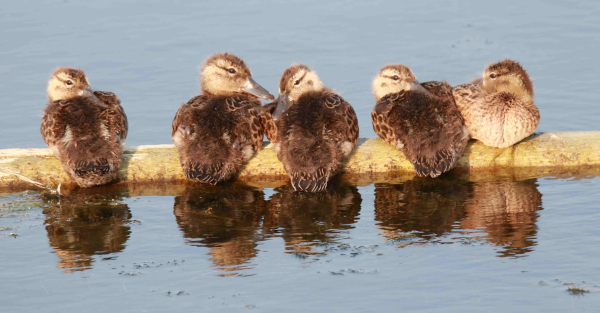
The subject of your photographs is all important, especially in bird photography. In short, you need a bird, or birds, to even begin. My almost daily birding drives are designed to find birds, and potentially, opportunities to take photographs of birds. During an evening birding drive last week, just as the prime light was beginning to dim a bit, I was driving along a little-used road that skirts the edges of several shallow wetlands. As I progressed slowly without much action, at the edge of the fourth marsh I spied a brood of ducklings resting near the roadside.
Just a few feet from the shore, 9 downy ducklings were spread out along the length of a discarded pole that was floating in the water, with a larger female separating the ducklings into groups of 5 and 4. As I rolled down my window, I could see the larger duck was a Hooded Merganser, and as it slipped into the water I took a couple quick photos as it began to swim away. I expected the ducklings to follow in quick succession, but as I inspected the ducklings they settled back into their napping position. That’s when I could see the ducklings didn’t match the female. It was quickly obvious the broad bills of the ducklings were not indicative of the merganser tribe. Hmmm.
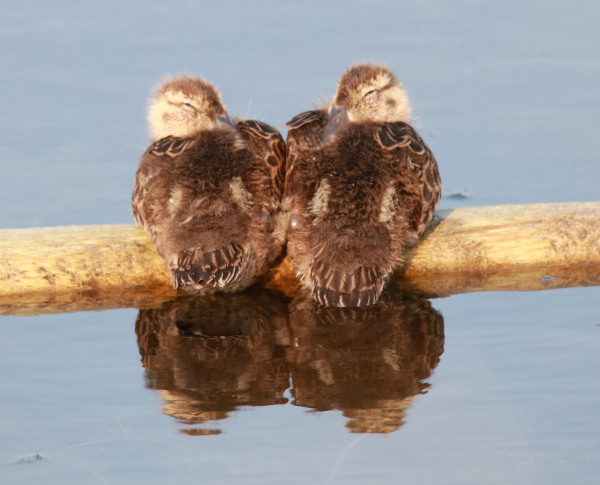
I quickly photographed the tightly huddled group of 5 ducklings in their downy resting mode, then pivoted to the next groups of 2 and 2. Having documented these cute little birds, I turned my camera to the Hooded Merganser again as it turned into a side view. That’s when I realized it wasn’t an adult female, but a fledgling that resembled an adult female; it had a slighter build than an adult with shorter crest feathers on the back of its head that were still growing. In short, this fledgling merganser was simply resting in the midst of a brood of unrelated ducklings. I photographed the merganser again, and turned my attention back to the brood.
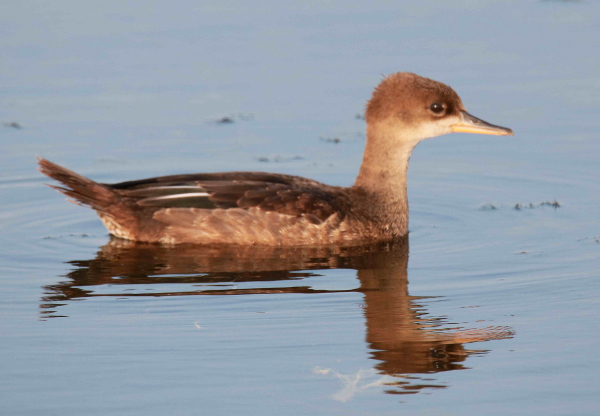
The young Hooded Merganser created an initial misunderstanding, when the much larger duck resting in the midst of the 9 ducklings suggested it was the female and the ducklings were young mergansers.
|
I surveyed the surrounding area, and didn’t see an obvious female duck that might be attached to this impressive brood of 9. My first guess was that these might be Mallard ducklings, but Blue-winged Teal are very similar, but smaller, so that was definitely possible. For these ducks, their age dictates their size, so the question really was whether these ducklings were 10-day-old Mallards or 2½-week-old teal? I continued to watch and photograph the ducklings, zooming in and out as needed to include different groups.
When I looked up again, I noticed a suspicious female Blue-winged Teal swimming slowly from north to south quite a distance away. When it made a contact call, one of the ducklings became alert, and when she called again, the duckling stood up and stretched, then hopped into the water, strongly suggesting this was “Mommy.” I expected the rest of the ducklings to quickly follow, but they showed an apparent lack of interest or concern at first. After moments and more calls, 1 and 2 and, eventually, all the ducklings headed for the hen and the rest of the brood.

I took a couple photos of the family group on the evening water as the ducklings began to pick food particles off the water surface, then wished them well as I looked for the next photo ops. Actually, the light was getting pretty dim for any more photos, at least on a quality level, but I kept alert as I drove the 8 miles home. I felt a sense of accomplishment after photographing the ducks, and I enjoyed the quick opportunity to document the birds at that point in the day, and in their lives.
With the best light of the evening dimming, the photo conditions dictated camera settings that had lower than usual shutter speeds, but the ducklings were mostly immobile so 1/320 and 1/500 were plenty fast while selecting an aperture of f7, which I increased to f9 when I photographed the family group to get more area in focus around the female Blue-winged Teal. Between you and me, I think if I had been a half-hour later I would have only been able to get documentary photos instead of photos with enough quality and interest to share with you. It’s all about timing, light, and persistence. Then too, a half-hour later the ducklings probably would have been swimming and searching for food with “Mommy,” just as I left them.
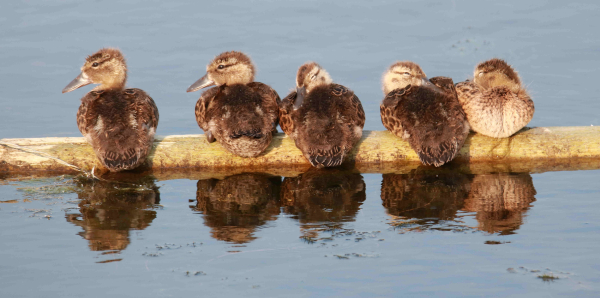
Keep your photo searches active and successful as summer continues. Certainly, each day more and more birds are joining the continental flock, so to speak; as new nestlings, fledglings bolster population numbers by multiples that probably at least double or triple the number of birds that started the nesting season. Hail the nesting reproductive season, and the ever-more abundant photo opportunities, and good luck birding with your camera in hand!
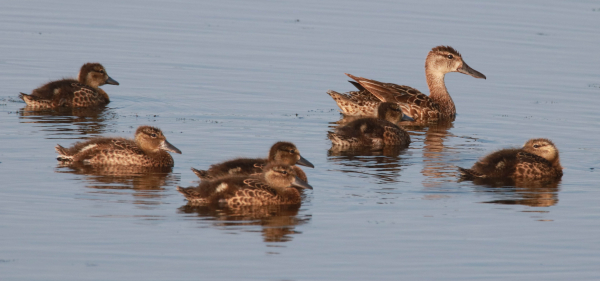
Article and photographs by Paul Konrad
Share your bird photos and birding experiences at editorstbw2@gmail.com